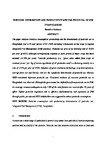Pesticide consumption and productivity and the potential of IPM in Bangladesh
| dc.contributor.author | Rahman, Sanzidur | |
| dc.date.accessioned | 2015-12-24T16:55:55Z | |
| dc.date.available | 2015-12-24T16:55:55Z | |
| dc.date.issued | 2013-02 | |
| dc.identifier.issn | 0048-9697 | |
| dc.identifier.issn | 1879-1026 | |
| dc.identifier.uri | http://hdl.handle.net/10026.1/4001 | |
| dc.description.abstract |
The paper analyses trends in consumption, productivity and the determinants of pesticide use in Bangladesh over a 33 year period (1977-2009), including a discussion on the scope to expand Integrated Pest Management (IPM) practices. Pesticide use grew at an alarming rate of 10.0% per year (p<0.01) although the corresponding response in yield growth of major crops has been minimal (<1.0% per year). Pesticide productivity (i.e., 'gross value added from crops at constant prices' per 'kg of active ingredients of all pesticides used') is declining steadily at a rate of -8.6% per year (p<0.01). Adoption of Green Revolution (GR) technology, crop diversification, average farm size and literacy rate are the most significant determinants of pesticide use, whereas research and development (R&D) investment depresses pesticide use. Consistent evidence of excessive pesticide use in Bangladesh was observed. Although the government has shifted focus from pesticide use to IPM, its coverage remains inadequate as only 7.4% of the total farmers are covered after 30 years of effort. Tighter pesticide regulation and its effective implementation, and expansion of IPM through public, private and non-governmental organisation (NGO) stakeholders are suggested to reduce pesticide consumption. | |
| dc.format.extent | 48-56 | |
| dc.format.medium | Print-Electronic | |
| dc.language | en | |
| dc.language.iso | eng | |
| dc.publisher | Elsevier BV | |
| dc.subject | Determinants of pesticide use | |
| dc.subject | Trend analysis | |
| dc.subject | Pesticide regulatory framework | |
| dc.subject | Integrated Pest Management (IPM) | |
| dc.subject | Bangladesh | |
| dc.title | Pesticide consumption and productivity and the potential of IPM in Bangladesh | |
| dc.type | journal-article | |
| dc.type | Journal Article | |
| plymouth.author-url | https://www.webofscience.com/api/gateway?GWVersion=2&SrcApp=PARTNER_APP&SrcAuth=LinksAMR&KeyUT=WOS:000316826800007&DestLinkType=FullRecord&DestApp=ALL_WOS&UsrCustomerID=11bb513d99f797142bcfeffcc58ea008 | |
| plymouth.volume | 445-446 | |
| plymouth.publication-status | Published | |
| plymouth.journal | Science of The Total Environment | |
| dc.identifier.doi | 10.1016/j.scitotenv.2012.12.032 | |
| plymouth.organisational-group | /Plymouth | |
| plymouth.organisational-group | /Plymouth/Faculty of Arts, Humanities and Business | |
| plymouth.organisational-group | /Plymouth/Users by role | |
| dc.publisher.place | Netherlands | |
| dcterms.dateAccepted | 2012-12-11 | |
| dc.identifier.eissn | 1879-1026 | |
| dc.rights.embargoperiod | Not known | |
| rioxxterms.versionofrecord | 10.1016/j.scitotenv.2012.12.032 | |
| rioxxterms.licenseref.uri | http://www.rioxx.net/licenses/all-rights-reserved | |
| rioxxterms.licenseref.startdate | 2013-02-15 | |
| rioxxterms.type | Journal Article/Review |


